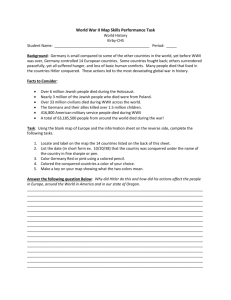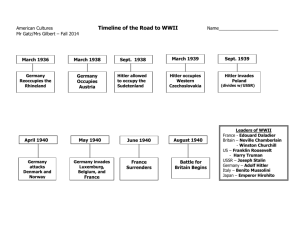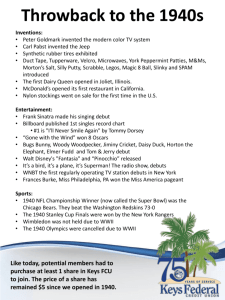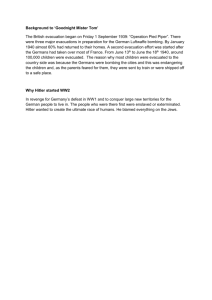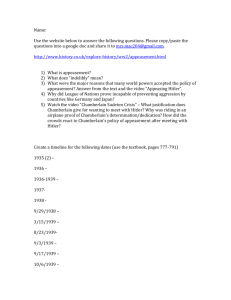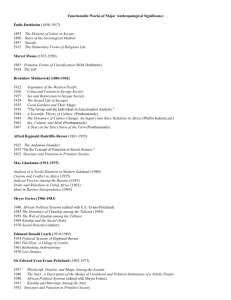slides
advertisement
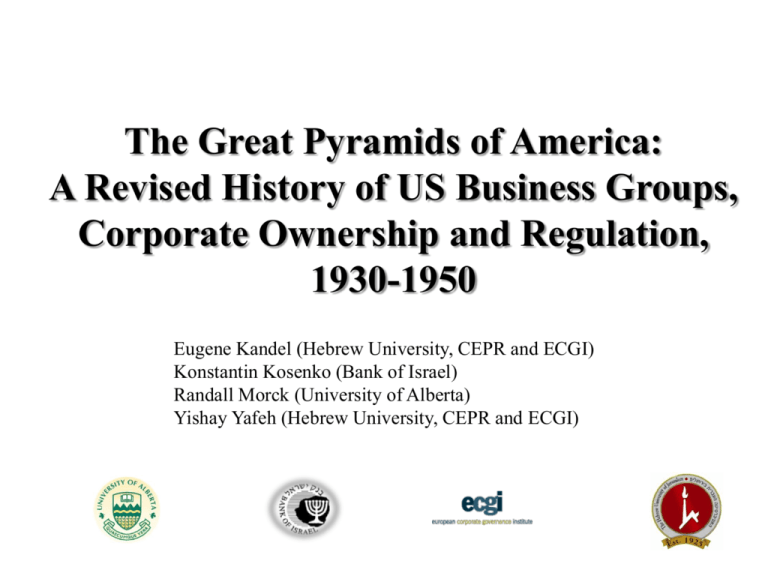
The Great Pyramids of America: A Revised History of US Business Groups, Corporate Ownership and Regulation, 1930-1950 Eugene Kandel (Hebrew University, CEPR and ECGI) Konstantin Kosenko (Bank of Israel) Randall Morck (University of Alberta) Yishay Yafeh (Hebrew University, CEPR and ECGI) A Typical Large US Corporation Today Minnesota Mining and Manufacturing Almost 100% ownership Domestic subsidiaries Almost 100% ownership Public Shareholders Widely held No controlling shareholder Freestanding Listed firms typically do not hold control blocks in other listed firms Edper Group EDWARD BRONFMAN TRUST Double-click to r eturn to pre vious page. Double-click to proce ed to the next page. 100 EDPER INVESTMENT LTD. BRONCORP INC. 50 EVEREST LTD. 19.5 EDPER ENTERPRISES LIMITED 50 50.1 BRA SCA N HOLDINGS INC. EDPER HOLDINGS INC. 49.9 CARENA HOLDINGS INC. 0 TUDORCROF INVESTMENT INC. 74.2 50.1 BRA SCA N HOLDINGS LTD. 75 HEES HOLDINGS INC. 25 51 50.1 PAGE 7,3,8,9 EDPERBRA SCAN CORPORATION 61.5 BROOKFIELD PROPERTIES CORP. PAGE 16,14 97.8 EDPER RESOURCES LTD. 47 CARENA HOLDINGS CORP. 100 EDPER HOLDINGS CORP. 100 EVEREST INVESTMENT LTD. 19.6 Bronfman Group (Canada) HECO SECURITES LTD. 51 WESTCHESTER ESTATE LTD. HEES INTERNA TIONAL BANCORP INC. PAGE 17 Anglo American Group (South Africa) 81 Main St Nom Oppenheimer Family Foreign shareholders 8.0% 5.2% 6.3% West DP Amplats 35.8% 50.0% Vaal RFS Amcoal Kloof 51.7% Afex 50.0% 8.8% AECI 5.3% 6.5% 11.1% Tongaat 5.5% First National 20.4% Highveld 8.2% Sanlam 24.8% Gencor 28.6% 24.5% 26.0% 27.6% 40.2% Southern Life 50.0% Premsab 9.5% 39.6% 5.1% Amgold Anamint 5.7% 35.2% Dries 23.4% De Beers Std Bank Nom Tvl 43.6% 51.0% Debswana Diamond 50.0% 23.7% 10.0% 38.4% 14.5% 39.4% GFSA 8.5% 8.3% 6.9% Amic 32.0% 13.1% 10.2% ANGLOS 49.7% 52.0% SA Mutual 8.8% 44.5% De Beers Centenary 29.4% 26.8% JCI 20.6% Bevcon 50.5% 22.6% Freegold 27.5% Samancor 36.3% Liberty 50.0% 28.3% Premier Johnnic 35.0% NEC 30.0% SA Brews Source: Financial Mail The Samsung Group Dark circle for company of more than 3 trillion in assets. Dark arrow represent circular equity investment. Source: Korea Investor’s Service, reproduced from Chang (2003) US Corporate Ownership Today Is Different Source: Masulis et al. (2011) When and How did US Corporate Ownership become “Exceptional”? Has it always been like this? Is common law inconsistent with pyramidal ownership structures? If it is not common law, • Is regulatory measures? • Is it economic reasons? • Is it politics? How does the history of corporate ownership in the US compare with the evolution of corporate ownership in the UK, Germany and Japan? This Paper: The US wasn’t always like that As in many countries today, until the middle of the 20th century, business groups dominated the US economy, controlling (at the peak of their activity) about 50% of all non-financial corporate assets as well as many powerful financial institutions As in many countries today, some groups were familycontrolled, pyramidal and diversified across a range of industries But some US groups were focused (undiversified) in one sector: public utilities and transportation Unlike most groups today, the holding (apex) company of many focused US groups was diffusely held, not family controlled What Led to the Absence of Groups in the US? None of the “Suspects” Did It Alone… Groups existed (since the end of the 19th century) - not inconsistent with US common law Groups continued to exist in the 1940s; 18 survived until 1950, some survived even later – their disappearance was gradual Group demise was not an immediate response to the introduction of any major regulatory measure of the 1930s Diversified family-controlled groups disappeared first Claim: the demise of groups in the US was due to a combination of regulatory forces applied against the backdrop of a special political climate Regulatory Forces at Play? • Establishment of the SEC and improved investor protection (1933-1934) PUHCA (starting 1935) Taxation of inter-corporate dividend (starting 1935) • The Investment Company Act (1940) • Antitrust enforcement (starting late 19th century) • Estate Taxes (starting 1916) Claim: A combination of factors, no single reason Additional Observations Did dual-class shares replace pyramids? Co-existed in early years; became unpopular/ prohibited in the late 1920s; no study of the link b/w the use of dual class shares in recent decades and “our” groups Great Depression and WWII: impact is ambiguous The academic and public discourse of groups in the 1930s: effects of groups on competition and politics in contrast with the modern focus on investor protection No clear link between business groups and the rise of conglomerates/multidivisional firms in the 1960s (group “alumni” firms were not involved in the conglomerate merger wave (Dirlam, 1970)) Introduction to Pyramidal Business Groups Ubiquitous Not conglomerates Often very large in size (e.g. the Wallenberg group in Sweden controls about 1/3 of market cap; Samsung revenues account for about 1/7 of Korea’s GDP) Upside: Groups can make up for missing institutions in various ways (e.g., Khanna and Yafeh, 2007) Downside: Monopoly power; rent seeking; minority shareholder expropriation (e.g., Morck et al., 2005) Policy makers in many countries (e.g. Korea, Israel, Italy) seek mechanisms to limit the downsides of groups/restrict their influence on the economy and politics Lessons from history/President Roosevelt: Relevance of the present study Pyramidal BGs in the US - History Use of holding companies becomes common towards the end of the 19th century (legal reform in NJ; replaces previous collusive arrangements, especially “trusts”(Moody, 1904)) [Not inconsistent with common law] Antitrust legislation starting in the late 19th century (Sherman Act (1890), Clayton Act (1914) and more) Proliferation of business groups, 1915-1928: Outside the scope of antitrust regulation; Competition for firm incorporation across States; Limited regulation; Preferential tax treatment; Also – “missing institutions” arguments for the formation of business groups Different types of groups emerge: widely held groups focused in utilities (and railroads); and diversified familycontrolled groups in other sectors Concerns emerge in the late 1920s: groups hamper competition; groups are risky to investors (collapse of the Insull Group); groups over-expand… Specifically on Groups in the US Legal scholars such as Bank and Cheffins (2010) Under-estimate the importance of groups (especially outside public utilities), “like” PUHCA Mahoney (2012) – finds negative effect of PUHCA on valuation (uses an event study methodology) Morck & Yeung (2005) – Taxation of intercorporate dividends as a crucial policy tool Perez Gonzales (Stanford WP, 2014): PUHCA affected the structure of utility groups and improved the performance of affiliates which became standalone entities Data: Sources and Construction Berle and Means’(1932) original list of the 200 largest non-financial corporations Track the evolution and structure of ownership using periodic reports from Moody’s manuals (Industrial, Public Utilities, Railroads) at six points in time: 1926, 1929, 1932, 1937, 1940 and 1950 Unbalanced panel ~ 2500 firms, 15,000 firm-years Financial reports/statements (incomplete) SEC annual reports (ICA and PUHCA Administration) Various other historical sources, newspaper archives and more… Data (contd.) Tests for sample selection do not reveal any serious bias: various contemporary sources with alternative lists of large companies vs. the list in Berle and Means Definition of a group: same ultimate owner, at least three publicly listed companies (stake < 95%) Robustness tests – groups of 4 or more Ignore non-voting shares but there seems to be no serious bias: ultimate owner’s holdings in preferred stocks ≈ holdings in common stocks (TNEC, 1940; Becht and DeLong, 2005); verify that widely-held groups are not indirectly family controlled US Business Groups No. of Family-controlled Groups (green) vs. Widely-held Groups (blue) Number of Group-affiliated Firms 1600 1514 1442 1400 1255 1200 976 1000 800 791 600 400 332 309 271 195 200 166 146 98 0 1926 1929 1932 No. of affiliates 1937 Public affiliates 1940 1950 Group Size - % of Total Corporate Assets 60% 50% 40% 30% 20% 10% 0% 1926 1929 1932 Total Assets Sources: Statistics of Income, Authors’ calculations 1937 Total Assets (non-financial corp) 1940 1950 3(1) 5(2) 2(0) 2(0) 3(0) Food 5(4) Metalworking Machinery 1(1) Petroleum Refining 1(0) Tobacco Motor Vehicles 1(1) Rubber and Plastics Electric Equipment 9(6) Chemicals Primary Iron and Steel Manufacturing 2(0) Construction Other Coal Mining 1(0) Finance and Insurance Public Utilities Transportation and Warehousing Repair /Construction Amusements 48(8) Textile Doherty Du Pont Harriman Hill Hopson Kuhn-Loeb Mellon Morgan Rockefeller Sinclair Van Sweringen Vanderbilt Williams Communications American Telephone & Telegraph Co. Anaconda Copper Mining Co. Atlantic Coast Line Co. Delaware Lackawanna & Western Rd. Co. International Tel. & Tel. Corp. Kennecott Copper Corp. Loew's Inc. Middle West Utilities Co. Pacific Lighting Corp Paramount Publix Corp. Pennsylvania Rd. Co. Southern Ry. Co Stone & Webster, Inc. Other Metal Products Family Groups Widely-Held Groups Business Group/Industry Wholesale and Retail Trade Distribution of Business Groups by Industry, 1932 36(5) 20(3) 11(5) 1(0) 1(1) 6(4) 8(3) 1(0) 10(0) 4(3) 1(1) 100(8) 5(3) 1(0) 8(4) 237(43) 38(5) 3(0) 1(0) 1(1) 1(0) 26(4) 25(5) 6(0) 17(4) 7(0) 49(1) 100(11) 72(13) 2(0) 2(0) 1(1) 35(6) 1(1) 48(4) 1(1) 2(0) 50(6) 1(0) 60(15) 235(19) 4(1) 1(0) 1(0) 4(4) 1(0) 4(3) 2(2) 8(8) 9(1) 4(1) 1(1) 1(0) 1(1) 2(2) 2(1) 4(1) 2(0) 1(0) 2(2) 29(2) 3(0) 1(0) 1(0) 3(1) 2(0) 1(0) 38(13) 11(6) 1(0) 1(0) The Share of US Business Groups in Selected Industries, 1932 100% 90% 80% 70% 60% 50% 81% 40% 30% 51% 20% 37% 30% 10% 0% 17% 0% 0% Textiles Construction 1% Trade 5% 6% 7% Services Mining and quarring Food products Rubber products Other Metal and its products Chemicals Transportation and public utilities Group Revenues in comparison with the Largest US Firms Today The largest group - the Morgan Group - had revenues of $46 billion in 1932 (2005 prices), about 6.5% of US GDP Larger (relative to GDP) than today’s largest American corporations such as Wall-Mart or Exxon-Mobil Comparable in size to LG or Hyundai in Korea (67% of GDP); Samsung, the world’s largest group is twice as large US Pyramids, 1932 Average Ownership Stake Held by Controlling Shareholders Number of companies Mean Publicly-traded 923 76% Group-affiliates 614 72% Stand-alone (non-affiliated) 309 85% Family-controlled groups 285 73.1% Widely-held groups 329 70.3% Population T-value (diff.) 7.47*** -1.32 Controlling Blocks in Group Affiliates, 1940 US Exceptionalism - 1 Business groups in the 1930s USA Business groups in most America countries in the 2000s exceptional? Commonplace Commonplace No Pyramidal structure Pyramidal structure No Large firms Large firms No Small control wedge Large control wedge Yes Industrially concentrated Geographically diversified? Industrially diversified Geographically concentrated Yes Many with widely held apex firm Apex firm is generally a family firm Yes The Disappearance of US Groups Number of Group-affiliated Firms 1600 1514 1442 1400 1255 1200 976 1000 800 791 600 400 332 309 271 195 200 166 146 98 0 1926 1929 1932 No. of affiliates 1937 Public affiliates 1940 1950 Group Size - % of Total Corporate Assets 60% 50% 40% 30% 20% 10% 0% 1926 1929 1932 Total Assets Sources: Statistics of Income, Authors’ calculations 1937 Total Assets (non-financial corp) 1940 1950 Proportion of Family-controlled vs. Widely-held Groups Surviving vs. Disappearing Groups The Securities & Exchange Act (1933) and the Establishment of the SEC (1934) Improved investor protection, disclosure rules etc. May have reduced “tunneling”? The disappearance of family firms (more tunneling prone?) Disappearing groups had somewhat higher control-CF wedges than surviving groups (but difference is small) Decline in the average number of pyramidal levels per group from 2.8 in 1940 to 2.2 in 1950 (significant) But investor protection was not the major concern of contemporary observers Link between improved investor protection and ownership structure not clear in other countries (Franks et al. on the UK, Japan, Germany The Public Utility Holding Company Act (PUHCA), 1935 Explicitly anti-group President Roosevelt in 1935: “among the subjects that lie immediately before us is… the restoration of sound conditions in the public utilities field through abolition of the evil features of holding corporations” Initially, restrictions on intra-group transactions and on lobbying In 1940, the “Death Sentence Clause” (reaffirmed by the Supreme Court in 1946): Connected infrastructure (not operations in NY and CA) One industry (not gas and electricity together) No more than two pyramidal levels PUHCA – Empirical Tests Use the SEC Report from 1951 to identify all companies affected by PUHCA Identify all companies the sample undergoing an ownership change (divestment, merger, bankruptcy etc. between 1937 and 1950) – there are about 900 such firms Out of these 900, 149 included in the PUHCA lists Out of 104 public companies undergoing an ownership change, 34 included in the PUHCA lists Out of 12 groups which disappear between 1940 and 1950, PUHCA strongly affected 5 (where at least a third of all public companies appeared on the PUHCA lists) Strong PUHCA effect on two additional groups which disappeared between 1937 and 1940 Groups whose “principal line of business” is Public Utilities vs. Other Groups (# of affiliates) Number of Pyramidal Levels in Public Utilities vs. Other Groups Properties Sold/Divested by Public Utilities Holding Companies, 1936-1955 Source: SEC Annual Reports PUHCA - Evaluation Clearly had an effect on groups with operations in public utilities But groups not in PU were not affected Mixed evaluation by contemporaries: Anderson (1947) views the prospect for PU groups as “quite good” SEC Chairman McDonald (1951) emphasizes considerable divestments and decline in geographic spread by many PU holding companies Inter-Corporate Dividend Taxation (1935) o Explicitly anti-group o Part of President Roosevelt’s anti-group strategy: fiat restrictions on holding companies in public utilities and taxation of inter-corporate dividends o Effect is proportional to the number of pyramidal levels o Effective rates increased over time o Preferential tax treatment for downsizing pyramids o Regarded as important in previous work by Morck and Morck and Yeung Statutory Inter-corporate Dividend Tax Rate Applied at Each Pyramidal Tier Inter-corporate Dividends to Total Dividend Payments, 1926-1950 Change in Controlling Blocks in Group Affiliates, 1940-1950 Dividend Taxation (Contd.) o Decline in the number of pyramidal levels may also be due to dividend taxation o Disappearing family-controlled groups more dependent on dividends? o Companies self-professing to initiating structural changes due to dividend taxation (early, in 1937) include two group affiliates o Bottom line: Looks like dividend taxation had an effect (more difficult to measure directly than the PUHCA effect) The Investment Company Act (1940) o Directed at investment funds and trusts o But potentially affecting holding companies? o President Roosevelt viewed investment companies as a means to concentrate economic power o ICA: disclosure requirements and limitations on related party transactions o Excludes companies involved in the railroads industry (supervised by the ICC) as well as holding companies included in the PUHCA o Excludes holding companies whose equity stakes exceed 50% The Investment Company Act (Contd.) No evidence that group affiliates were included in lists of affected companies (investment funds) No evidence of legal battles in courts related to ICA Could the increase in controlling blocks between 1940 and 1950 to levels exceeding 50% (and lower than 85%) be related to ICA? Change in Controlling Blocks in Group Affiliates, 1940-1950 Rejuvenated Antitrust Enforcement (1940s) Antitrust was weak between the 1920s and the 1940s (President Roosevelt said so; enforcement expenditures data reported in Fligstein, 1990) As in the case of PUHCA we compare lists of companies involved in antitrust cases with lists of companies undergoing ownership changes after 1940 (only 66 antitrust cases in the 1930s): 640 antitrust cases during the 1940s/900 firms undergoing ownership changes (104 public companies) Of which only 15 involved group affiliates Of which only four were public companies Of which two cases were dismissed Antitrust enforcement did not directly affect groups Marginal Federal Estate Tax Rate at the Highest Wealth Level, 1916- 1960 Source: Gale and Slemrod (2001) Existing Mechanisms for Dealing with Estate Taxes No Clear Link b/w Succession and Group Demise Complete Avoidance Unlikely? Many court cases in the 1920s on the exaggerated use of these devices? (Leaphart, Cornell Law Rev, 1930) New Deal reduced tax loopholes? (Brownlee et al., 2002) Donations/charity correlated with tax rates? (Fack & Landais, 2011; Clotfelter, 2012) Other Factors Glass-Steagall adversely affected ICMs? ICC/railroad regulation: Did not attempt to reform the industry which was in decline World War II: Increased concentration and government contracts? Politics and the anti-group atmosphere were clearly important (in the spirit of work by Roe and others) Robustness: Groups of 4+ Listed Companies Family-controlled (green) and Widely-held Groups (Blue) 30 25 20 14 15 15 11 7 10 9 4 12 5 9 8 10 8 6 0 1926 1929 1932 widely-held groups 1937 family groups 1940 1950 Conclusions/Lessons BGs (of certain types) are not incompatible with common law and investor protection The public discourse about them need not focus on minority shareholder expropriation In an institutionally developed democracy, antigroup regulation is unlikely to yield immediate results due to legal (and political) challenges A combination of forces and the right political climate are needed to achieve a dramatic ownership change? (Japan as another example) Even measures which did not affect groups directly contributed to generating the right “climate”? Evolution of Ownership in Major Economies UK: Always dispersed, even before the introduction of formal investor protection measures (Franks et al., 2009) Japan: The dissolution of groups and improved investor protection led to bank dominance and cross-shareholding based on block holders (Yafeh, 1995 and Franks et al., 2014) US: Institutional similarity to the UK but nevertheless concentrated ownership and business groups until the middle of the twentieth century US: Anti-group policy shocks as in Japan but a very different ownership structure as a result

